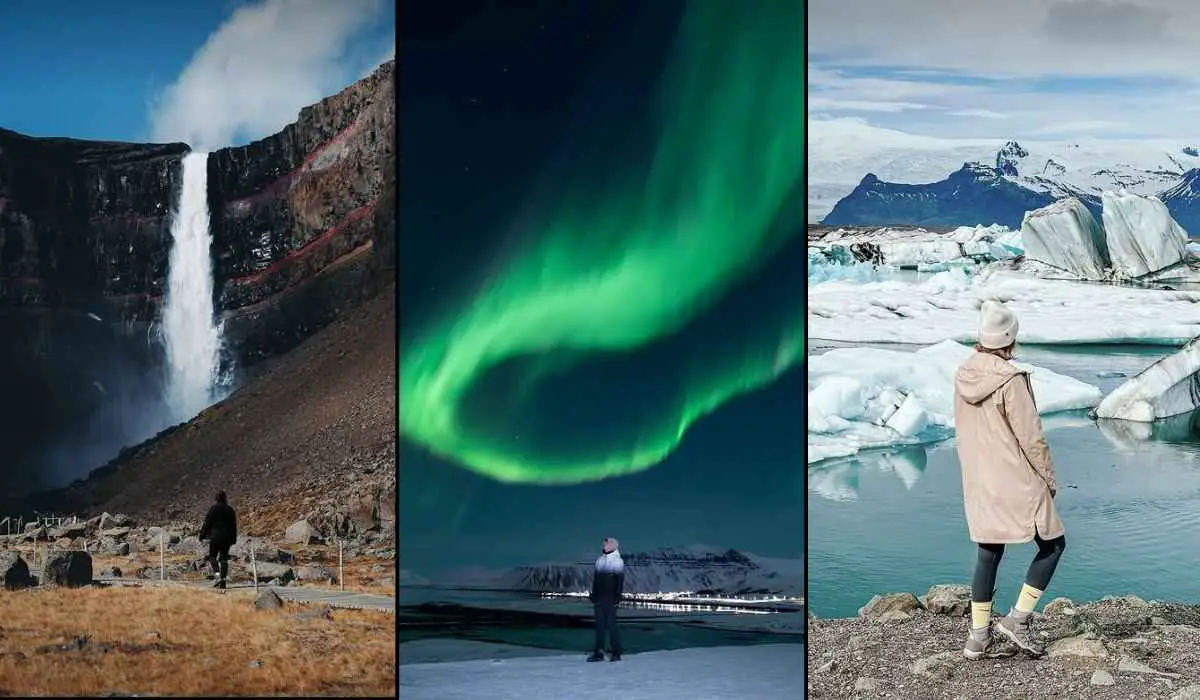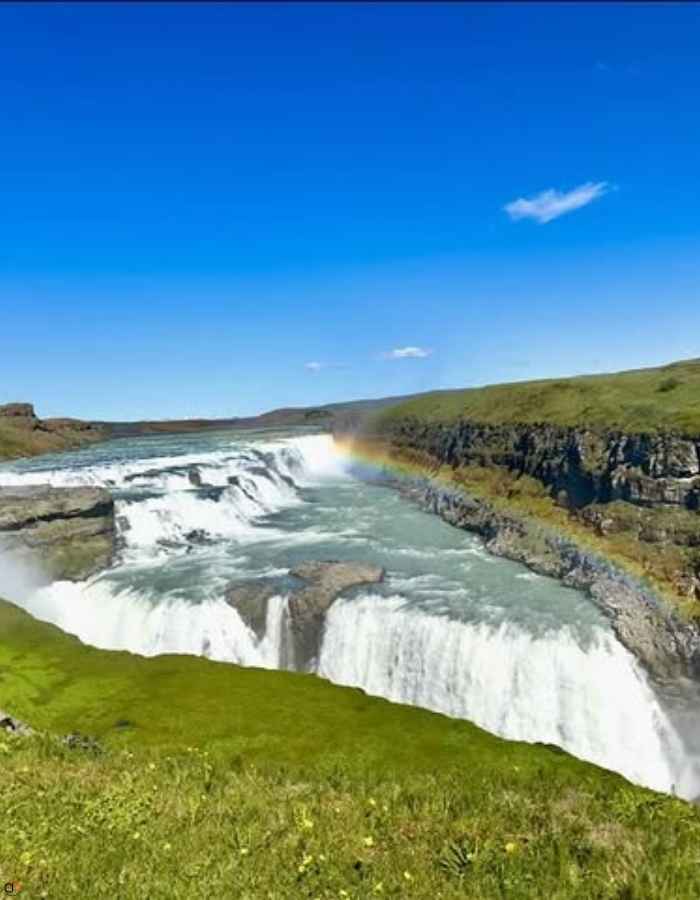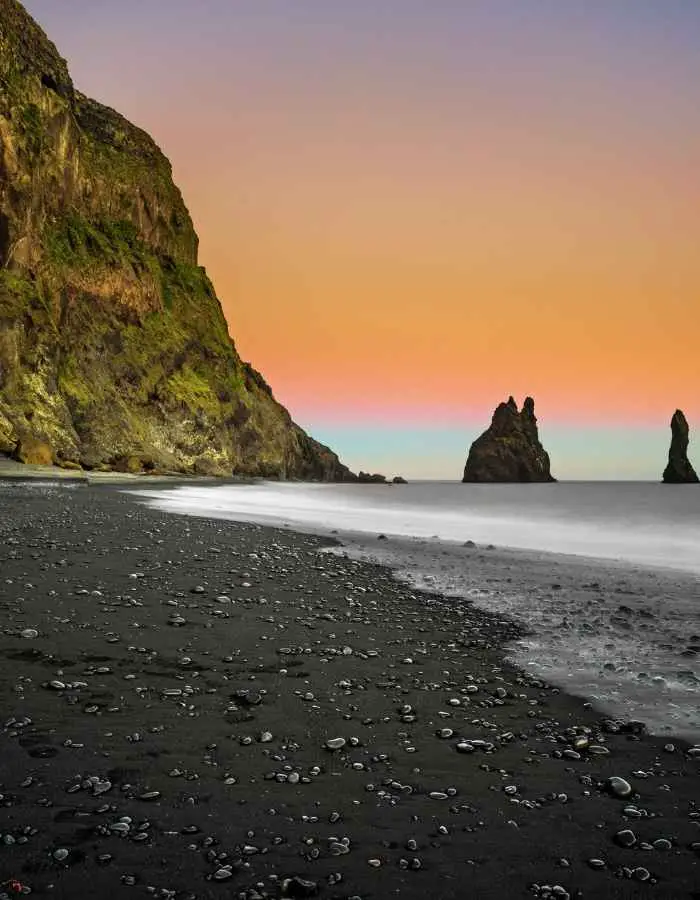Iceland — a land of otherworldly landscapes, dramatic waterfalls, and shimmering northern lights.
If you’re chasing glaciers, soaking in natural hot springs, or exploring vibrant Reykjavik, this Nordic island offers an unforgettable adventure for every kind of traveler.
Join me as we dive into the magic of Iceland Travel and discover why it should be at the top of your travel bucket list.
Why Visit Iceland?
Iceland is unlike any place on Earth — a dramatic blend of fire and ice where nature takes center stage. From thundering waterfalls and black sand beaches to steaming hot springs and colossal glaciers, every corner of this island feels like stepping into a fantasy novel.
One of the top reasons to visit Iceland is its raw, untouched beauty. The landscapes are surreal and constantly changing, shaped by volcanic eruptions, shifting glaciers, and geothermal activity. Whether you’re gazing at the Northern Lights dancing across the winter sky or basking in the midnight sun during summer, the natural phenomena alone make Iceland unforgettable.
But it’s not just about scenery. Iceland offers a rich cultural experience as well — with warm, welcoming locals, a vibrant arts scene in Reykjavik, and a deep connection to Viking history and folklore. The island also stands out for its sustainability, clean air and water, and safe, solo-traveler-friendly environment.
In short: If you’re craving a destination that combines adventure, tranquility, and wonder — Iceland delivers it all in spectacular fashion.
Top Natural Attractions:
Iceland’s landscape is a masterpiece carved by ice and fire, offering an array of natural wonders you won’t find anywhere else. if you’re a nature lover, photographer, or adventure seeker, these must-see Iceland Travel spots will leave you breathless.
1. The Golden Circle
A classic route that packs in some of Iceland’s most iconic sights:
-
Þingvellir National Park – A UNESCO World Heritage Site where you can walk between two tectonic plates.
-
Geysir Geothermal Area – Home to the original geyser and its active cousin, Strokkur, which erupts every few minutes.
-
Gullfoss Waterfall – A powerful two-tiered waterfall that’s especially stunning in winter when partially frozen.
2. Jökulsárlón Glacier Lagoon & Diamond Beach
Watch massive icebergs drift through a glacial lagoon before washing up on a nearby black sand beach, glistening like diamonds under the sun — a surreal and magical sight.
3. Blue Lagoon
A famous geothermal spa with milky-blue waters rich in silica and minerals. It’s the perfect place to unwind after a day of exploring, and yes — it lives up to the hype.
4. Reynisfjara Black Sand Beach
Located near the village of Vík, this beach features striking basalt columns, sea stacks, and crashing Atlantic waves. A dramatic and moody landscape straight out of a fantasy film.
5. Skógafoss & Seljalandsfoss Waterfalls
Two of the most photogenic waterfalls in the country:
-
Skógafoss drops 60 meters and often creates rainbows on sunny days.
-
Seljalandsfoss lets you walk behind the waterfall for a rare and thrilling perspective.
6. Vatnajökull National Park
Home to Europe’s largest glacier, this park offers glacier hikes, ice caves, volcanic craters, and dramatic mountainscapes. Nature here is on a whole other scale.
7. Snæfellsnes Peninsula
Often called “Iceland in Miniature,” this region packs in lava fields, glaciers, coastal cliffs, and the iconic Kirkjufell mountain — one of the most photographed spots in the country.
Outdoor Activities and Adventures:
Iceland is a playground for outdoor enthusiasts, offering a unique mix of adrenaline-pumping adventures and serene natural experiences. Whether you’re braving the glaciers or diving between continents, the island’s wild terrain promises unforgettable moments.
1. Glacier Hiking and Ice Climbing
Strap on your crampons and trek across ancient ice on glaciers like Sólheimajökull or Vatnajökull. With a guide, you can even explore deep crevasses or try your hand at ice climbing.
2. Whale Watching
Húsavík is often called the whale watching capital of Europe. Hop on a boat tour to see humpbacks, orcas, and even blue whales, especially during the summer months.
3. Puffin Spotting
Visit coastal cliffs like Látrabjarg or islands like Vestmannaeyjar to see Iceland’s cutest residents — the Atlantic puffins. Peak puffin season runs from May to August.
4. Hiking and Trekking
From the colorful rhyolite mountains of Landmannalaugar to the dramatic trails of Fimmvörðuháls, Iceland offers hikes for every skill level. Summer is ideal for longer treks in the highlands.
️5. Snowmobiling on Glaciers
Get your adrenaline fix by snowmobiling across icy expanses like Langjökull. It’s a thrilling way to explore Iceland’s remote glacial terrain.
6. Snorkeling or Diving in Silfra
At Þingvellir National Park, you can snorkel or dive in the Silfra fissure, a crack between the North American and Eurasian tectonic plates. The water is crystal-clear and filtered through lava for decades.
7. Camping and Stargazing
For a more laid-back adventure, camp beneath the stars in Iceland’s countryside. In winter, this offers some of the best conditions for viewing the Northern Lights.
8. Riding Icelandic Horses
Try a peaceful ride on the unique and sturdy Icelandic horse, known for its smooth gait and friendly temperament. Rides are available year-round through lava fields, valleys, and along beaches.
If you’re chasing thrills or soaking in the serenity, Iceland’s outdoors offer something for every kind of explorer. Ready for your next adventure?
When to Visit:
| Season | Months | Weather | Daylight Hours | Highlights | Best For |
|---|---|---|---|---|---|
| Summer | June – August | Mild (10–15°C / 50–59°F) | Up to 24 hours (midnight sun) | Lush landscapes, puffins, festivals | Hiking, road trips, camping, wildlife |
| Fall | Sept – Oct | Cool (5–10°C / 41–50°F) | 8–13 hours | Fewer crowds, autumn colors, early auroras | Budget travel, Northern Lights begin |
| Winter | Nov – Feb | Cold (-5 to 5°C / 23–41°F) | 4–7 hours | Snowy landscapes, ice caves, Northern Lights | Aurora viewing, winter sports |
| Spring | March – May | Chilly (0–10°C / 32–50°F) | 10–16 hours | Melting snow, fewer tourists, baby animals | Waterfalls at full force, transitions |
Quick Tips:
-
Peak Season: June–August (book accommodations early!)
-
Best for Northern Lights: Late September to mid-April
-
Most Affordable: Shoulder seasons — spring and fall
-
Best Weather: July and August (still bring layers!)
Practical Travel Tips:
Traveling to Iceland is a thrilling experience, but being well-prepared can make all the difference. Here are some essential tips to help you make the most of your trip — safely, smoothly, and on budget.
1. Getting Around
-
Rent a car for flexibility, especially if you plan to explore the Ring Road or remote regions. 4×4 vehicles are recommended in winter.
-
Fuel is expensive, so plan fuel stops and use apps like “Vedur” and “Veðurkort” for weather and road updates.
-
If you’re not driving, guided tours and public buses are good alternatives for popular routes.
2. Accommodation
-
Book well in advance during summer and holidays.
-
Options range from hotels, guesthouses, and Airbnbs to farm stays and camping.
-
Many accommodations include shared kitchens, which help save on food costs.
3. Budgeting
-
Iceland is pricey — especially food, alcohol, and gas.
-
Save by:
-
Shopping at local supermarkets like Bonus or Krónan
-
Bringing a reusable water bottle (tap water is pure and free!)
-
Choosing free or low-cost attractions (many natural sites have no entrance fees)
-
4. What to Pack
-
Layers are key. Weather changes quickly — bring waterproof and windproof outerwear.
-
Hiking boots, gloves, thermal base layers, and swimwear (for hot springs) are essentials.
-
In winter, pack crampons or shoe spikes for icy paths.
5. Connectivity and Payments
-
Free Wi-Fi is widely available.
-
Iceland is almost completely cashless — credit/debit cards are accepted everywhere.
-
Consider getting a local SIM card or an international data plan if you plan to drive.
6. What Not to Do
-
Don’t stop randomly on the road for photos — it’s dangerous.
-
Avoid off-road driving — it’s illegal and damages the fragile environment.
-
Never underestimate the weather. Always check forecasts and travel advisories.
With the right preparation, you’ll spend less time worrying and more time enjoying Iceland’s incredible natural beauty. Safe travels!
Icelandic Culture and Cuisine:
Iceland’s charm goes beyond its jaw-dropping landscapes — it’s also deeply rooted in a resilient, creative culture shaped by nature, history, and a strong sense of community. From ancient sagas to modern art, and fermented shark to fresh lamb stew, Iceland offers a cultural experience as unique as its terrain.
A). Culture: Where Old Meets New
-
Viking Heritage: Icelanders are proud descendants of Norse explorers. You’ll find references to Vikings in museums, literature, and even street art.
-
Storytelling Tradition: Iceland has one of the highest numbers of authors per capita. Don’t miss out on the Icelandic Sagas — epic tales of heroism and history.
-
Creative Spirit: Reykjavik buzzes with modern culture — think music festivals, avant-garde fashion, and an energetic art scene. Icelandic music, from Björk to indie bands, reflects the country’s experimental soul.
-
Language: Icelandic has changed very little since medieval times. While it may be tough to pronounce, almost all locals speak excellent English.
-
Community: Iceland is known for its safe, welcoming vibe. With a population of just around 380,000, there’s a strong sense of trust and togetherness.
B). Cuisine: Simple, Fresh, and Bold
Icelandic food is rooted in survival and tradition but is also evolving with a modern twist. You’ll find everything from centuries-old preservation methods to high-end Nordic cuisine.
1. Must-Try Dishes:
-
Lamb: Grass-fed and tender, often served roasted or in a hearty stew (kjötsúpa).
-
Fresh Seafood: Arctic char, cod, haddock, and langoustine are local favorites.
-
Skyr: A thick, protein-rich dairy product similar to Greek yogurt — creamy and delicious.
-
Hot Dogs (Pylsur): A national obsession! Try one “eina með öllu” — with everything.
-
Rúgbrauð: A dense, sweet rye bread traditionally baked underground using geothermal heat.
2. For the Adventurous:
-
Hákarl: Fermented shark — often described as an acquired taste. It’s a cultural rite of passage!
-
Svið: Boiled sheep’s head — a traditional dish not for the faint of heart.
3. Drinks & Desserts
-
Brennivín: Iceland’s signature spirit, often served with fermented shark.
-
Coffee Culture: Icelanders love their coffee — you’ll find cozy cafés almost everywhere.
-
Kleinur: A twisted, fried pastry often enjoyed with coffee.
-
Icelandic Ice Cream: Locals eat it year-round, even in freezing temperatures!
Take Away:
Iceland is a land of striking contrasts — where glaciers meet volcanoes, and ancient legends live alongside modern innovation.
If r you’re soaking in hot springs, chasing waterfalls, or exploring Viking culture, Iceland offers unforgettable experiences year-round.
With the right planning and a sense of adventure, your trip to the Land of Fire and Ice will be nothing short of extraordinary.
Read Next; Check Out Outdoor Travel Needs
FAQs:
1. Is Iceland expensive to visit?
Yes, Iceland is known for being pricey. However, costs can be managed by traveling in shoulder seasons, cooking your own meals, and booking early.
2. Do I need a visa to visit Iceland?
If you’re from the Schengen Area, U.S., Canada, or many other countries, you can visit Iceland visa-free for up to 90 days. Always check current entry requirements before traveling.
3. Can I see the Northern Lights all year?
No — the Northern Lights are visible from late September to mid-April, with the best viewing on dark, clear nights away from city lights.
4. Is it safe to drive in Iceland?
Yes, but conditions can be challenging in winter. Check weather and road conditions daily and rent a 4×4 vehicle if traveling outside summer.
5. What currency is used in Iceland?
Iceland uses the Icelandic króna (ISK). Credit and debit cards are accepted almost everywhere, so cash is rarely needed.
6. Is English spoken in Iceland?
Yes, most Icelanders speak fluent English, especially in tourist areas, making communication easy.
7. What’s the best time to visit Iceland?
It depends on your interests:
-
Summer for hiking, road trips, and endless daylight
-
Winter for Northern Lights, snow, and fewer crowds




